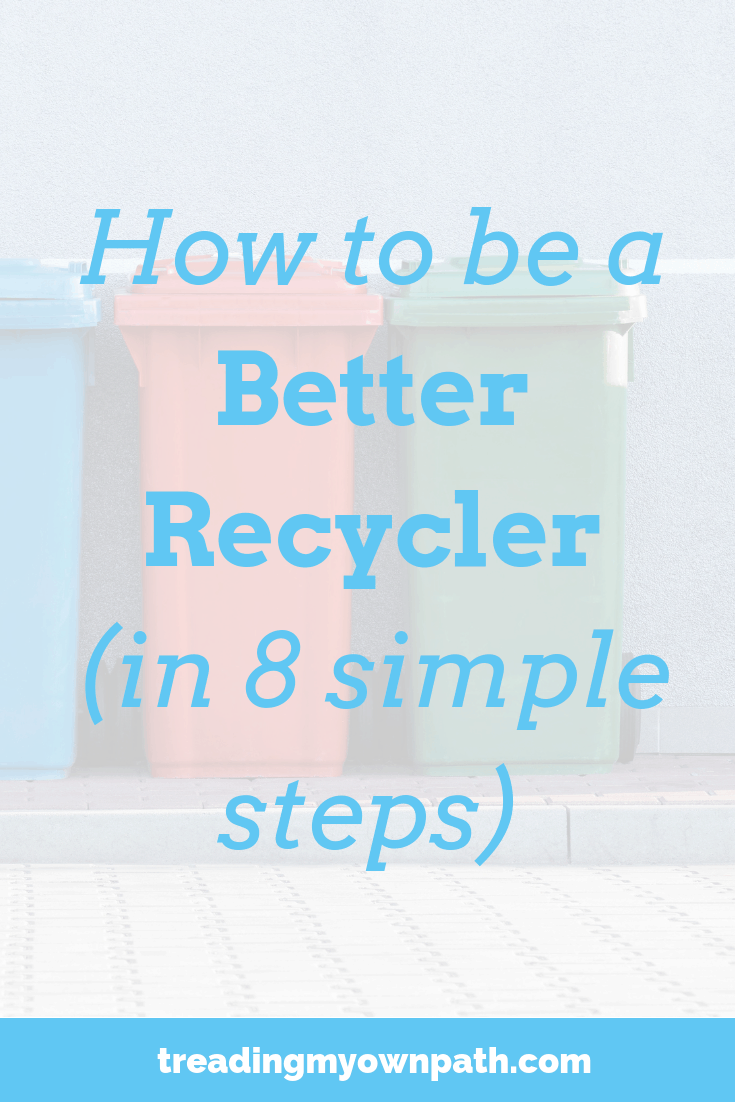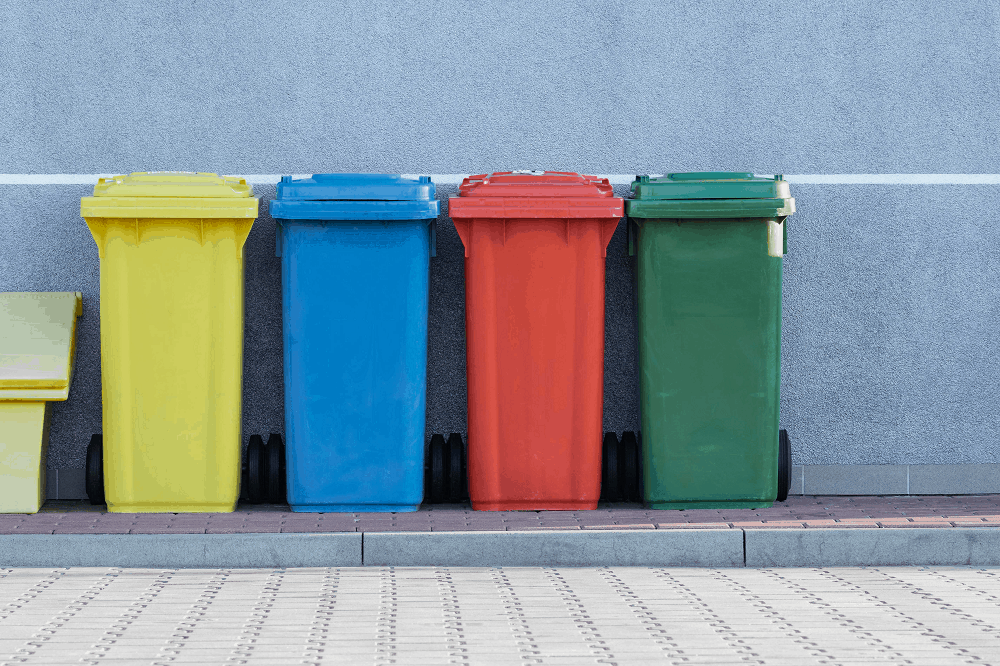How To Be A Better Recycler (in 8 Simple Steps)
I don’t love recycling. I’d much rather things didn’t need to be recycled in the first place, either because I’ve avoided them or because they are being reused exactly as they are. Much better to refill a jam jar than for it to be picked up from my kerbside, driven to a resource recovery centre, separated, crushed, melted down and manufactured back into a new jam jar.
Much as I don’t love recycling, it’s a necessity. We all recycle things.
When we start out on our waste reducing journey, recycling is the perfect place to start, because recycling is much better than landfill.
Down the track, we learn to reduce our recycling. But recycling doesn’t drop to zero.
So if we are inevitably going to recycle things, let’s be the best recyclers that we can be. Recycling correctly is better than recycling incorrectly.
Whether you’re a plastic-free or zero waste newbie, or whether you’ve been on the journey for a while, there’s probably the opportunity for you to be a better recycler. Here’s 8 tips to consider.

1. Get informed on what can be recycled where you live
There’s a big difference between ‘theoretically recyclable’ and ‘actually recycled’. Lots of things can be recycled in theory, but they aren’t – because it’s too expensive to process, there’s not enough volume for it to be viable, or there’s not enough demand for the recycled product.
Companies want us to think that their products are recyclable and so they splash recycling logos all over the packaging. But if it’s not a material that is recyclable in your area, it won’t be recycled, however much both you and the company who produced the packaging want it to be.
You need to find out what’s recyclable in your area. What’s recyclable overseas or even in the next town isn’t necessarily what’s recyclable for you.
If you have kerbside recycling, it is your local council that provides the service (either themselves, or contracted out). Contact them to find out what can and cannot be recycled. They’ll probably have information on their website, but you can also call and ask to speak to the waste officer.
2. Follow the Rules!
Recycling is different everywhere, and the rules that your council or recycling provider tell you to follow are the ones that you need to follow. If you see something that seems like a much better idea on the internet but goes against what your local council says to do, don’t be tempted!
3. Clean your recyclables
Whether your council tells you to or not, it’s always better to rinse out your dirty recyclables. (Use the water at the end of your washing-up, and give them a quick rinse.) There’s a chance that someone somewhere might have to handle them, or breathe in the air where they’re processed and stored.
It might not be necessary for the machinery, but it is better for the people who work in the industry. Dried-on fermented cat food or sour milk never increased the value of recyclables, ever.
4. Check for updates regularly
What’s recyclable now isn’t necessarily the same as what was recyclable 6 months ago, and it might change again 6 months into the future. That’s because recyclables are commodities, and their value increases and falls with supply and demand. Many materials recovery facilities sell recyclables using short-term contracts, maybe as little as 3 months.
Fluctuating markets affect price, and if something isn’t valuable enough to recycle, it won’t be recycled.
Don’t assume that just because you checked the council recycling guidelines once in 1997 that the information you remember from then is still relevant today. It probably won’t be! It is much better practice to check in with your local council every three months or so, to find out what’s changed.
5. Look for alternative solutions (beyond kerbside recycling)
Recycling isn’t limited to kerbside collection systems. Plenty of things can be recycled at drop-off points provided by your council or at collection bins at businesses and more responsible retailers. Textiles, light bulbs, paint, scrap metal, printer cartridges, eWaste (old electronics) and oil can all be recycled.
As well as your council website, these national recycling databases have information for where to take recycables:
recyclingnearyou.com.au (Australia)
earth911.com (USA)
recycleforscotland.com (Scotland)
recycleforwales.org.uk (Wales)
recyclenow.com (England)
6. Don’t wishcycle
Wishcycling is when we put something in the recycling bin and hope it will be recycled, even though we know the recycling bin isn’t the proper place for it. Don’t do it! (Yes, we all want everything to be recyclable and we all feel guilty about landfill. But wishcycling isn’t the answer!)
Recycling properly can take a little more work, to find out where to go and then drop the item off. In the scheme of things, it isn’t a very big ask.
I was once told by the guide of a tour of a materials recovery facility, that the craziest thing he ever saw in a yellow-lidded kerbside recycling bin was a car door. Of course, being made of metal, a car door is completely recyclable. But it isn’t meant to go in the kerbside recycling bin! The materials recovery facility is not set up to deal with that kind of material, and incorrect materials damage machinery. The car door could have been taken to a scrap metal recycler instead.
Take the time to find out the best place for the item you want to recycle. And if you really can’t find a place to take the item to be recycled where you live, accept that it has to go in the landfill bin.
(Your next step is to figure out how to avoid that item again in the future.)
7. Less Recycling is Better
When I say ‘be a better recycler’ I do not mean ‘recycle more’. Less recycling is better. That’s less trucks on the roads, less machinery sorting materials, less energy spent processing our recyclables, less resources consumed.
An empty recycling bin is better than a full recycling bin.
Yes, at the start of our journey we all start out with a full-to-overflowing recycling bin. Plus if you’re anything like I was, you’re mightily proud of said overflowing recycling bin.
It’s a journey, and one that starts with maximum recycling works towards minimum recycling.
First we learn exactly what goes into our recycling bin, then we learn where to recycle all the other things, and then we start to think about how to reduce our recycling.
Recycling is where we start. It is not where we stop!
8. Refuse, reduce, reuse (before recycling)
Recycling is only one up from landfill; it’s a not-quite-last-but-not-far-off resort. If we’re going to create less recycling, we need to be thinking further up the waste stream. We need to be thinking about refusing, reducing and reusing.
Refusing happens when we avoid the packaging and materials that will need to be recycled in the first place. Choosing loose produce over the prepackaged stuff, not taking a plastic bag, asking for no plastic straw.
Reducing happens when we know we need some kind of packaging, but we try to limit what we take. Opting for the bigger packet rather than the multi-pack of individually wrapped packets, or choosing a single bottle of juice over several juice boxes.
Reusing happens when we either take our own reusables to the shops: produce bags for fruit and veg, containers for trips to the deli and other counters, a coffee cup to the local cafe.
By looking at the packaging in our recycling bin we can see exactly where we might do better, and start looking for solutions, one item at a time.
Now I’d love to hear from you! How does recycling work where you live? Do you have kerbside recycling? Where else can you take your recycables? How have you managed to reduce your non-recycables? Anything else to add? Please share your thoughts and experiences in the comments below!
[leadpages_leadbox leadbox_id=1429a0746639c5] [/leadpages_leadbox]



